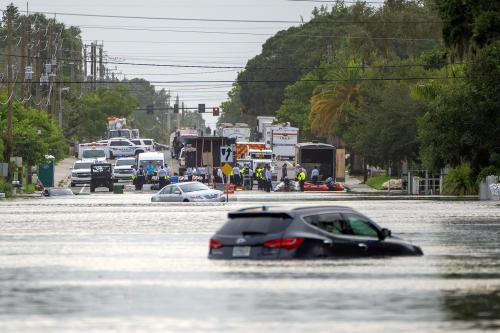Content from the Brookings Institution India Center is now archived. After seven years of an impactful partnership, as of September 11, 2020, Brookings India is now the Centre for Social and Economic Progress, an independent public policy institution based in India.
Much has been written about the death spiral U.S. and some European utilities face because of the rise in renewable energy production and use. With high if not saturated energy demand, and the falling costs of renewables, more and more end users, especially higher-end consumers, are opting for distributed renewable generation. This reduces their grid demand (if not cutting the cord completely). This hurts the utilities’ sales, which then have a smaller consumer base to pay for the shared infrastructure, which raises costs, which prompts more people to leave the grid, and so on.
Whether true or exaggerated, a corollary question for India and other emerging economies yet to reach 100 percent electrification and supply is can they leapfrog to a renewables-centric grid? The answer is no, at least not in the foreseeable future. Even in the West, few solutions are 100 percent decentralized; the grid still provides back-up and stability.
Pricing Is a Greater Challenge than Renewables
While a renewables-driven utility death spiral isn’t likely soon in India, there are other spirals and challenges India faces. For starters, demand is nowhere near saturation. With a quarter or more of rural homes unelectrified, and most electrified homes facing supply outages (dubbed “load-shedding”), demand will grow, perhaps 6-8 times before reaching a semblance of saturation.
Indian utilities face different threats, beyond the well-known issue of losses, theft, and shortfalls in supply. With low prices for small consumers (based on a tiered tariff structure), much of the latent demand is not profitable for utilities; and the remote and rural consumers are the most expensive to wire. Worse, their household demand comes during the evening peak, when supply is tight. Socially important pushes for universal electrification strain utility finances. If utilities were to implement time-of-day consumer pricing to help incentivize peak generation, this would raise the peak tariff. However, renewables, especially solar, would not be able to compete as easily at such hours.
Competition spirals and viability challenges come not from renewables, but from broader electricity pricing challenges. Simple “cost of generation” comparisons miss the fact that not all generation is equal. Retail prices in India are disconnected from the cost of generation (procurement by distribution utilities) not just because of average cost pricing, but also because procurement itself lacks time of day pricing. Lack of mark-to-market pricing (where the last transaction sets the price for all units, even in the past at different prices, such as with stocks,) means that state owned generation costs (averaged out, including older and cheaper units) come out cheaper than virtually all new plants, further diminishing the pressure on many retail consumers to shop elsewhere for power.
This also means that electricity prices will rise faster than inflation. While fuel, labor, and other commodity costs may go up “just” by inflation, the average electricity procurement cost is low due to older and cheaper plants. However, newer plants are all measurably more expensive than average procurement costs, regardless of whether public or private (imported coal or liquid fuel plants are just extreme examples of this). A hypothetical example (ignoring losses): a 10 percent growth in procurement from entirely “expensive” new generation (say, 50 percent more expensive than the average) pushes the average price increase above inflation (of perhaps 7 percent) by another 3.9 percent. This is even before pricing in peaking power, which is inherently expensive. The answer isn’t necessarily to move to mark-to-market pricing – such a step would raise procurement costs overnight – but at least the marginal costs must be accounted for and signaled to generators and procurers.
Decisions for Utilities: Face the Music and Plan Ahead
Pressure on prices includes the fact that distribution utilities are bleeding money; a 2012-13 annual accounts filing by a major Indian distribution utility showed that over 97 percent of its total revenues (including non-operations revenues) was spent on procuring power. That leaves very little for operations, maintenance, salaries, let alone capital investment, R&D, or profitability.
Pressures from renewables are not the key problem, since such private generation also faces high wheeling charges or, in some cases, official cross-subsidy charges. Instead, pressure comes from today’s cross-subsidies across consumer categories and tiered consumption, where over-paying commercial and industrial consumers have maximum incentive to leave the system (either legally or illegally), further straining the rest of the system.
There are other spirals and pressures on utilities, such as privatization or franchising operations in urban areas, which might be the only viable geographies that private entrants want to enter. This will leave the rest of the utility with lower-revenue consumers.
Facing such pressures, and just struggling to keep the lights on, renewables aren’t very high on utility executives’ minds. For now. But over time, the renewable energy-driven utility death spiral will also reach India. But by then, battery and smart grid technologies would have matured further, forcing even greater transformations on utility business models and regulations. India needs to become transparent in its electricity accounting, to enable greater efficiency, encourage diverse and qualitatively different generators, and offer incentives to save energy both overall and at the peak. With some effort, India can move to a virtuous cycle, with better electricity supply leading to a growth in GDP, paying for improved supply, and so on.
The Brookings Institution is committed to quality, independence, and impact.
We are supported by a diverse array of funders. In line with our values and policies, each Brookings publication represents the sole views of its author(s).



Commentary
No Imminent Renewables “Death Spiral” for India’s Utility Companies, but Other Challenges Are Looming
June 10, 2014